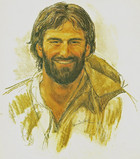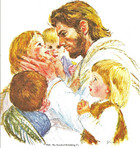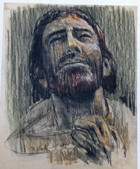Frances and Richard Hook
Frances(d.1983); Richard (1914-1975)
American Artists Frances and Richard Hook were the perfect husband-and-wife sacred art illustration team. Each had their own style of drawing, but they were able to meld them together to create images, which appeared to be the work of a single hand. Both were “lefties” and would sit together at the same drawing board, working on the same sketches. Richard concentrated on the male figures, while Frances blocked out the woman and children. Together, they created a warm and winning image of Christ for modern viewers, corresponding more closely to the “personal savior” of Evangelical Christianity.
Frances was born in Ambler, Pennsylvania. Richard must also have come from the same part of the country, since the couple met as students at the Pennsylvania Museum and School of Industrial Art (now the University of the Arts) in Philadelphia. After their marriage, Richard found work in an advertising agency and provided illustrations for popular journals like Collier's and The Saturday Evening Post. Frances had a successful freelance career in commercial art, creating a popular series of dewy-eyed children for Northern Tissue (Northern Paper Mill) advertisements of the late 1950s. When the demand for original commercial art waned in the 1960s, the couple turned their attention to the growing inspirational art market.
When the Hooks took up sacred commercial art, the field was dominated by one special image of Jesus: Warner Sallman’s Head of Christ. This backlit, celebrity photo-like portrait of a Nordic-featured, beautifully coiffed Christ was viewed as too effete and effeminate for the Swinging Sixties. Richard met the need for a more masculine Jesus with his own rugged, sunburned (somewhat Semitic-looking) Head of Christ for Concordia Publishing House. His was a dynamic Good Shepherd who carried no rod nor staff to get his flock through fearsome valleys. Frances also challenged conventional pious portraiture with images of an accessible Savior who laughed, doted on (always adorable) children, and in every way embodied the popular hymn title, What a Friend We Have in Jesus.
As Frances described their creative process in a newspaper interview toward the end of her life, the couple would look for a young male model about Christ’s age “with good bone structure and proportions” and have him pose for photos in a costume, resembling the robe Jesus might have worn. Working from these photos, Richard would sketch out the face of Christ. Frances suggested fixes if the features looked too old or did not convey enough gentleness or kindness. As she explained: “All you can do is portray the character traits you would expect to find in him.” It proved to be a winning formula in illustrations for best-selling religious publications like Kenneth Taylor’s The Children‘s Living Bible from Tyndale Publishing House.
The Sacred Art Pilgrim Collection has acquired preliminary sketches on themes from the life of Christ by the Hooks, no doubt, intended for submission to Christian publishing houses. Richard has signed the image of the praying Christ with half-closed eyes and a similarly featured Jesus, blessing the fish in the miracle of the feeding of the five thousand. The portrait of the Crucified Christ also appears to be his. The two sketches of the Annunciation and Christ's healing of the Centurion's servant could be the work of both Frances and Richard. The figure of Mary in the former drawing is, probably, by Frances' hand.
As the Hooks well knew, illustration work can provided art-makers with a steady income, but it does have decided drawbacks, imposing limitations on personal creativity. As a note on their decidedly different Annunciation sketch reads: "This is just idea...Can do another Mary Annunciation." It never seems to have made it into print.











